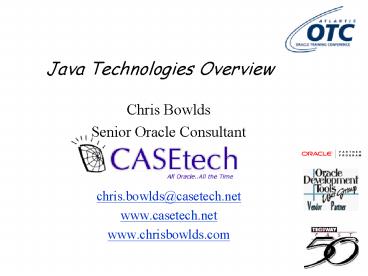Java Technologies Overview - PowerPoint PPT Presentation
1 / 16
Title:
Java Technologies Overview
Description:
Outline the Oracle products that implement these technologies. Introduction to JDeveloper ... Specified by Sun. Implemented by Application Server vendors. ... – PowerPoint PPT presentation
Number of Views:38
Avg rating:3.0/5.0
Title: Java Technologies Overview
1
Java Technologies Overview
- Chris Bowlds
- Senior Oracle Consultant
- chris.bowlds_at_casetech.net
- www.casetech.net
- www.chrisbowlds.com
2
Goals
- Introduce the three major Java Editions
- Describe the major technologies for the first two
- No detailed wireless coverage
- Outline the Oracle products that implement these
technologies
3
J2SE, J2EE, J2ME
- Java 2 Standard Edition (J2SE)
- Used to write standalone Java Applications and
Applets - Java 2 Enterprise Edition (J2EE)
- A set of APIs and server specifications built on
top of J2SE for building web applications. - Java 2 Micro Edition (J2ME)
- A pared down version of J2SE and APIs for
wireless and embedded device programming.
4
J2SE
- Not just a language a platform
- Key terms
- JVM Java Virtual Machine
- A virtual (imaginary) machine that binary code is
compiled to, rather than platform dependent
binary formats. - .java files -gt .class files -gt run by the Java
interpreter - JRE Java Runtime Environment
- The runtime implementation of the JVM.
- All you need to run Java programs and Applets.
- SDK Software Development Kit
- Needed to develop Java programs
- Includes the JRE to run Java
- Bundled with JDeveloper (if you download the big
one) - Used to be called Java Development (JDK)
5
J2SE
- http//java.sun.com/j2se/1.4.2/docs/index.html
6
Select Component Descriptions
- Java Runtime Typically java.exe or jre.exe
- What actually runs interprets .class files.
- Part of the JRE.
- Java Plug-in
- Allows running Java Applets in a web browser.
- Java Web Start
- Application deployment technology supporting
automatic updates and secure runtime environment.
7
API's you're likely to need as an Oracle developer
- java.lang
- Standard classes such as Object, System, Integer,
and String - java.util
- Collections, Date, Math, StringTokenizer, etc.
- javax.xml
- Java API for XML Processing (JAXP)
- Document Object Model (DOM), Simple API for XML
Processing (SAX), and Extensible Stylesheet
Transformation (XSL) support. - java.sql
- JDBC - database access
- javax.swing
- Graphical User Interface (GUI) toolkit. Write
custom Forms widgets.
8
J2EE
- Built on J2SE - does NOT stand alone!
- A set of specifications for writing components
that will run in standard J2EE servers. - (Supposedly) brings the portability of Java to
web development.
9
J2EE - Three Primary Technologies
- Servlets
- Server side Java code.
- Similar to PL/SQL web code, but written in Java.
- Java code that has print statements to generate a
web page. - JSP's
- JavaServer Pages
- Server side Java code.
- The inverse of a Servlet HTML code with Java
code embedded. - EJB's
- Enterprise JavaBeans
- Java components that encapsulate business logic
to be shared across the enterprise.
10
Typical N-Tier Architecture
11
Containers, Components
- A standard design pattern in J2EE is the use of
Containers and Components. - Containers
- Specified by Sun
- Implemented by Application Server vendors.
- Handle the plumbing code so that application
programmers can focus on business logic. - Components
- Written by application programmers to run inside
of Containers. - Focus on business logic.
12
Examples of Containers and Components
- Servlets and JSPs
- The Servlet Container (Tomcat, 9iAS, etc.)
handles plumbing code such as TCP/IP network
traffic using the HTTP protocol, using cookies to
store session data. - The Servlet Components (written by developers)
use APIs to interact with the Container. Code
focuses on business logic. - EJBs
- The EJB Container (9iAS, JBoss, etc.) handles
plumbing code such as distributed communication,
threading, scaling, transaction management, and
even persistence. - The EJBs (written by developers) use APIs to
interact with the Container. Code focuses on
business logic.
13
Other Prominent J2EE Technologies
- JNDI
- Java Naming and Directory Interface
- A standard API for talking to directories, such
as EJB servers and LDAP directories. - JMS
- Java Messaging Service, for asynchronous
interactions. - This is getting increasingly important for
scalability. - Java Mail
- Web Services support
- JAR, WAR, EAR files
- Theyre all in .zip format.
- Java, Web, and Enterprise Archives, respectively.
- Standard file formats used for deploying Java
applications.
14
Java in Oracle
- Client Tier
- Forms 9i client runs as an Applet
- Behavior of Applet is based on .FMX files
- Can have custom Java Beans embedded
- Middle Tier
- Forms 9i server
- Custom Java code can be imported and run on the
Forms server. - 9i Application Server (9iAS)
- Oracle Objects For J2EE (OC4J) is Oracle's J2EE
server implementation - Servlets, JSPs, EJBs, JMS, etc.
15
Java in Oracle
- Database Tier
- Capability of running J2EE code, but DON'T.
- This has been replaced by 9iAS.
- Java Stored Procedures
- Works great on small things.
- Have encountered problems when there are a lot of
dependencies on third party code on an upgraded
database. - Probably completely safe on a freshly installed
database.
16
Contact Information
Chris Bowlds chris.bowlds_at_casetech.net www.chrisb
owlds.com
202 543 4499
GSA IT Schedule GS-35F-0605M
www.casetech.net































